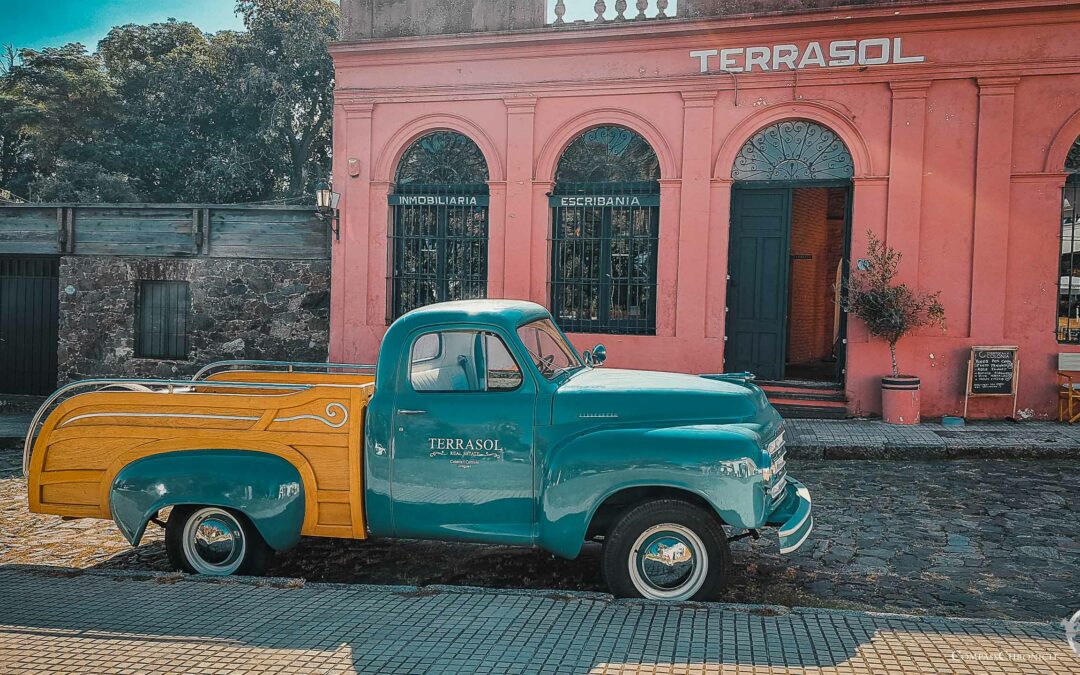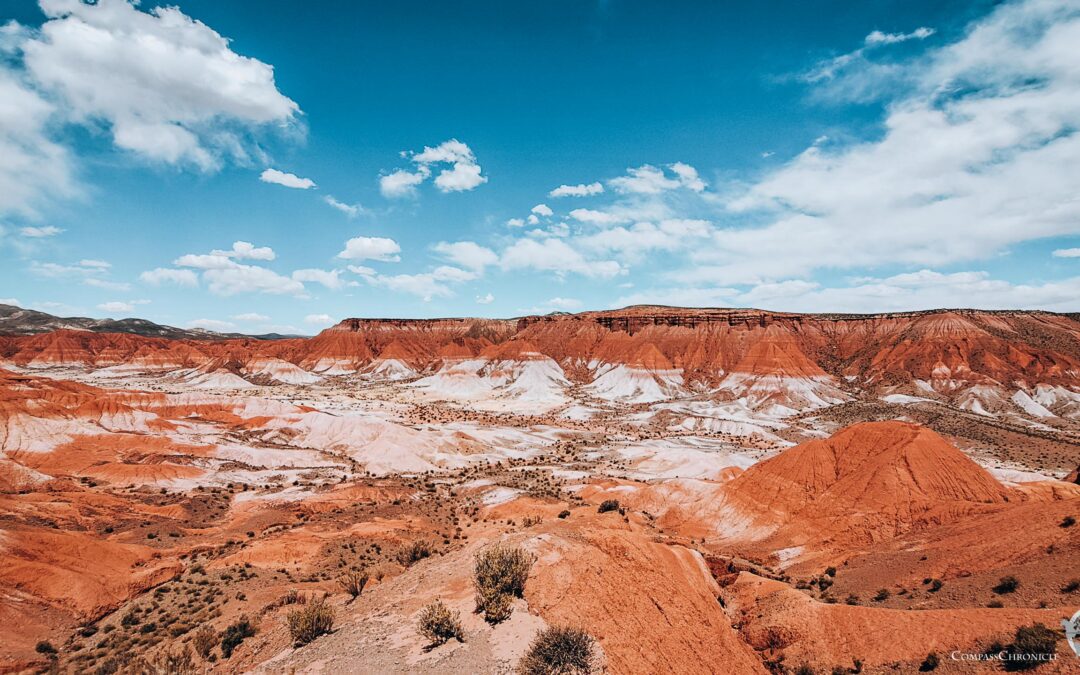Our numerous experiences on Tenerife do not all fit into one blog post. Therefore, here we present the second part. Here is the link to the blog post Tenerife – Part 1, so that you can easily read our experiences on Tenerife chronologically.
We are currently traveling the northwest coast of Tenerife. The scenery is dominated by the prominent mountain in the middle of the island. Pico del Teide is the highest mountain in all of Spain and is of volcanic origin. It reaches 3715m in height. Whether we will climb this peak in the future, remains to be seen. Now we visit Icod de los Vinos.
Icod de los Vinos
The town of Icod de los Vinos is built a few hundred meters above the sea in the slope of the Pico del Teide. Here we quickly find very steep passages, which we just barely manage with our van Ben. In the village itself it does not get much flatter, the relatively narrow streets between the buildings do not necessarily make navigating easier. The old part of Icod de los Vinos consists of a few rows of houses bordering the town square with the church of San Marcos Evangelista. We really feel like we are in a mountain village in Icod de los Vinos instead of being in a bigger town. The main attraction is the ancient dragon tree which stands in its own botanical garden. It is said to be over 800 years old, depending on who you ask even over 1’000 years. Since we recently visited the botanical garden in La Orotava, we take a look at the dragon tree from the viewing platform in the city park. There are other attractions in Icod de los Vinos besides the dragon tree, such as an animal park with butterflies.
But today we want to walk through the nearby picturesque town of Garachico before the big tourist rush. So directly after seeing the dragon tree and a short stroll through the old town we continue our journey.
Garachico
The village of Garachico, contrary to the town of Icod de los Vinos, is not located on a hillside, but again directly on the sea. It seems to us that this village is strongly connected to the sea. There is a marina and the shoreline is nicely arranged, partly with restaurants directly on the sea front. We walk through the ancient alleys and look at the different old houses. They are really cute little streets in the center of Garachico.
We visit a small park dedicated to the history of the town: Puerta de Tierra. It is the old city gate which stands in the center of the small park. We draw a small circle, passing by the sea front back to the biggest square of the town. As usual in Spain, this square is surrounded by restaurants and cafes. With that it is easy for us to stop for a little breather in a restaurant and let the scenery take its effect on us. At such places we often amuse ourselves by watching the never-ending stream of tourists. The scenery with the church and the green planted Plaza de la Libertad completes our picture.
We continue our journey in western direction until we arrive in the most northwestern village of Tenerife. In Buenevista del Norte we spend 2 nights before we venture to a real Tenerife highlight.
Masca – an idyllic mountain village
In probably every travel guide to Tenerife and in every travel blog Masca is mentioned. Some time ago, Masca was probably a real insider tip, has now developed into one of the two biggest tourist magnets on Tenerife. We will come to the second main attraction a little later in our series about Tenerife.
The idyllic mountain village of Masca is located in a rather impassable area in the middle of a nature reserve on Tenerife. The surrounding hill ranges are rugged and covered with the typical sparse yet green flora of Tenerife. We know about the big streams of tourists and so we leave early in the morning to hopefully get ahead of the biggest rush. And indeed, the big rush does not start before 11 o’clock. We enjoy the winding road from the north coming over various hill ranges with the magnificent view over the rugged ridges to the lower lying sea.
There are several viewpoints along the road which we of course like to take advantage of. Shortly before Masca we pass the viewpoint La Cruz de Hilda. We decide, in view of the still available parking spaces here, to enjoy the view of Masca with a fresh mango juice and coffee. Wonderful, the sun in the face, a light and pleasantly cool mountain breeze and the fantastic view over the few houses which form Masca.
There is a hike in Masca through the canyon of Masca down to the sea. Only a few years ago this path could be walked in one direction combined with a boat trip around the cliffs of Los Gigantes. Unfortunately, the landing stage is closed during our visit, so at the moment the hike can only be done as a round trip from Masca and back. For this we would have needed tickets which are unfortunately sold out several months in advance. Therefore, we ourselves cannot report on this hike.
The onward journey to Puerto de Santiago becomes more and more difficult with increasing traffic. We are not a small vehicle with our Sprinter, but by far not the biggest either – countless big cars and even busses filled with tourists to bring them to Masca are coming towards us. The road gets narrower and narrower, often without separated lanes, and the vehicles have to wait to pass each other in wider places of the road. Through steep hairpin curves with oncoming traffic, which does not always leave or make room, we drive slowly to our destination for the day. Luckily, we have already visited Masca and are on our way back, this drive with all the tourists in their rental cars costs some nerves!
Now we spend a few leisurely days in the southwestern area of Tenerife before we turn to our next sightseeing.
Boat trip to the cliffs of Los Gigantes including whale watching
While driving through Masca we got a small foretaste of the rugged cliffs of Los Gigantes. The cliffs of Los Gigantes, which drop off into the sea at one end and at the other end of which – roughly – Masca is located, can also be visited with a boat tour. Tenerife is also known for whale watching between the islands of Tenerife and La Gomera. Thus, several tour operators combine these two attractions in one boat tour. The tour itself is leisurely and we sail around the Atlantic Ocean for about four hours.
The first stop is whale watching. And quickly our captain finds a cluster of pilot whales. Laymen can easily mistake them for dolphins. Good that we have a very talkative tour guide on board who tells us about the species and their way of life with a microphone over the stereo system in 4 languages at the same time. This multilingual commentary in staccato tempo amuses us as well as the great sight of the pilot whales from the catamaran.
The tour continues to the cliffs of Los Gigantes. Here we see the turning point of the hike through the canyon of Masca, the Playa de Masca. For all swimmers among the visitors, the boat stops here for a swim in the sea. It is wonderful to float in the water directly besides the cliffs that drop vertically into the sea. At the same time enjoying the view into the canyons between the rock formations and out to the width of the sea. Such a bathing stop is worthwhile in any case.
There are tours both from the town of Los Gigantes and from Costa Adeje. It is worthwhile to compare the availability of the different providers and their prices in both places. We finally booked a tour from Costa Adeje. The place has more to offer and especially for van travelers there are enough places to park with our Ben at Adeje.
Hiking in the Barranco del Infierno, Adeje
Near Costa Adeje there is a picturesque hiking trail into a river arm that has been washed out for centuries. Since we are already in the region anyway, we decide spontaneously to make this hike. Therefore, we book – as is often the case – the hike in advance.
The equipment for this hike is very safety orientated: We are obliged to wear a helmet for the hike because especially on the last hundred meters there is danger of falling rocks. Well, so we play by the imposed rules of the game and start the walk into the gorge equipped with good shoes and a helmet. The path first leads along one side of the valley into the increasingly narrow riverbed. On both sides, the rock rises several hundred meters into the air. The gorge is thus definitely impressive.
The path has been prepared very well by the park rangers, so that we have no technical difficulties to overcome on the hike. The destination is the waterfall at the back of the gorge. With other hikers we walk leisurely past the special flora to the destination. On the way we meet cacti and stop again and again to look at the view of the rock formations and along the watercourse.
Finally, during our visit, the river was rather a trickle and the waterfall accordingly with little water rather modest. Of course, it is also clear to us, it cannot always be a waterfall in the dimensions of the Niagara Falls. Nevertheless, we started with other expectations on the hike.
We enjoy the excursion into the nature on foot, the waterfall becomes more and more a minor matter for us because the special landscape draws us in the spell again and again.
Last but not least, of course, the selfie with helmet may not be missing!
This is our second part in the series about vanlife on Tenerife. Soon we will publish the next post about Tenerife with our next experiences. The volcano El Teide is certainly still on our program and what else we experience, you can read in the next blogpost.




















0 Comments